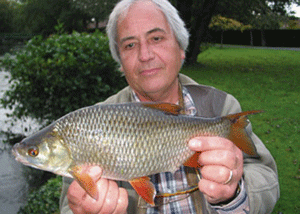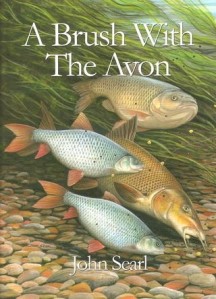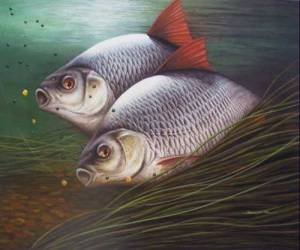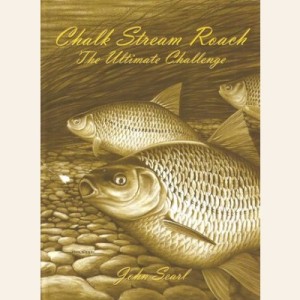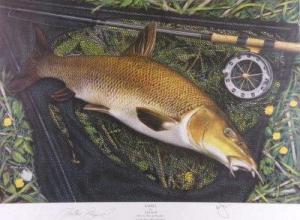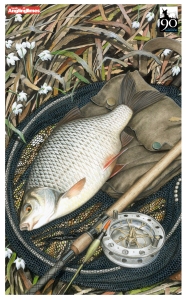A Mr.Joseph Turner had an idea, and made a fishing reel at his Pomfret Street workshop that turned very easily and the wooden ‘swimming’ fishing reel was born. We call them ‘trotting reels’ nowadays, but until 1960 or so they were swimming reels.
He was instantly copied but these reels were heavy and improvements were inevitable. Later Henry Coxon had a brainwave….probably inspired by his brother’s work making bicycles and made the spoked reel using lighter woods and ebonite, a vulcanised rubber compound. A fishing pal of FWK Wallis and JW Martin, Coxon was taken seriously when he took the idea to Allcocks in 1896 and the reels went into production.
I’m deeply indebted to a fellow Traditional Fisherman’s Forum member who has allowed me to illustrate some of his collection of these reels. But he’s no collector for collecting’s sake…he fishes with these beauties regularly. See how the reels slowly changes to ones of aluminium construction as this metal became cheaper and was better understood. 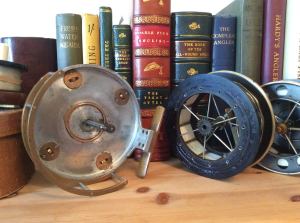 An ebonite spool with silver steel rim on a Allcock’s Aerial Rollerback.
An ebonite spool with silver steel rim on a Allcock’s Aerial Rollerback.
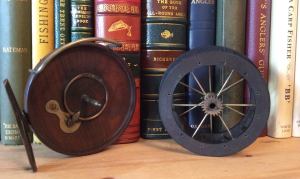 An ebonite Coxon with mahogany body. Note the check pawl is pivoted to ease its application as it enters the caliper check spring.
An ebonite Coxon with mahogany body. Note the check pawl is pivoted to ease its application as it enters the caliper check spring.
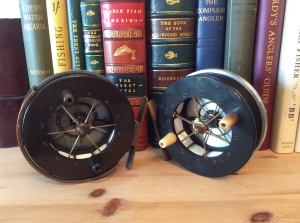 Ebonite spooled Aerials on aluminium bodies.
Ebonite spooled Aerials on aluminium bodies.
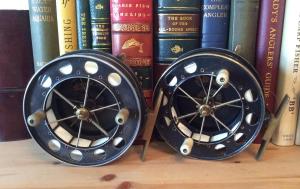 Aluminium Aerial reels with lever-operated checks.
Aluminium Aerial reels with lever-operated checks.
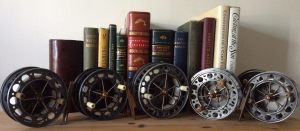 A selection of JW Youngs built Aerial reels, by this time JW Young had left Allcocks to start his own firm, but these aerials were only ever supplied to Allcocks, not other firms. One might suspect that a gentleman’s agreement was made…how on earth would JW have the money to start up a business for himself without support from his previous employer?
A selection of JW Youngs built Aerial reels, by this time JW Young had left Allcocks to start his own firm, but these aerials were only ever supplied to Allcocks, not other firms. One might suspect that a gentleman’s agreement was made…how on earth would JW have the money to start up a business for himself without support from his previous employer?
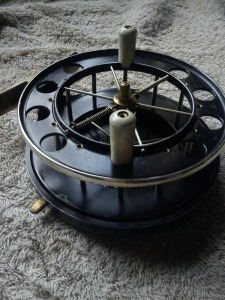
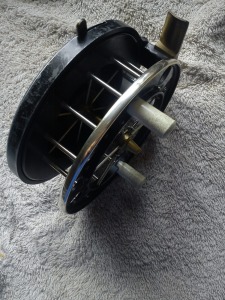 My personal favourite. An Aerial T10 with lever operated check, but this one has had a nickel-silver rim sweated onto the spool. Never advertised, these reels are extraordinarily rare, but it’s not that which attracts me so much as the practicality of using a lever-check and the sheer workmanship and beauty of that rim………sigh….
My personal favourite. An Aerial T10 with lever operated check, but this one has had a nickel-silver rim sweated onto the spool. Never advertised, these reels are extraordinarily rare, but it’s not that which attracts me so much as the practicality of using a lever-check and the sheer workmanship and beauty of that rim………sigh….
One of the last pre-War Aerials offered was the T3 and T6, respectively 3 and 4 inches wide., catalogue No.7950, occasionally offered ‘double ventilated’, that is to say that both faces of the spool, both back and front, were ‘ported’ or drilled to make the reel lighter and allow the circulation of air to dry the line.
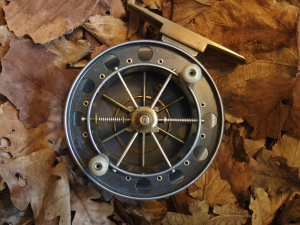
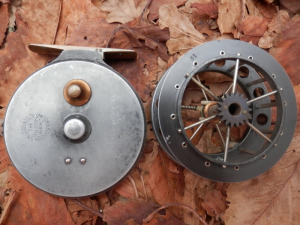 Compare this T3 backplate to the later post-War C815 illustrated later………..a very different reel.
Compare this T3 backplate to the later post-War C815 illustrated later………..a very different reel.
In 1939 Youngs made a new reel for Allcocks, it was simply called the Aerial Match, but the War intervened and it was only made for the one year.
. 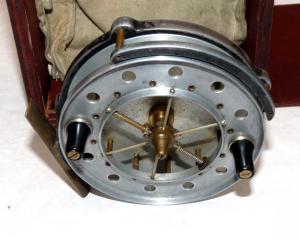
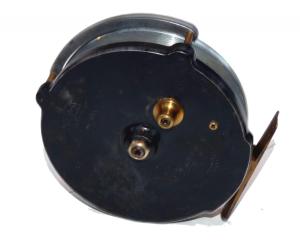 Here’s the entry from the 1939 Allcocks Guide:
Here’s the entry from the 1939 Allcocks Guide:
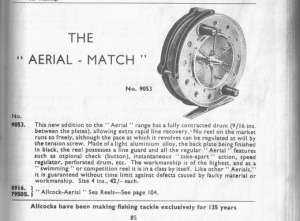 The story is that the molds for making the castings were either lost during the war, or wrecked by bombing….I don’t think anybody really knows the truth of it.
The story is that the molds for making the castings were either lost during the war, or wrecked by bombing….I don’t think anybody really knows the truth of it.
Post-War Allcocks offered a new reel, simply called the Aerial, it is nowadays known by its catalogue number C815, but Allcock’s in their 1949 Guide used an image of the old pre-War 7950 to illustrate it! 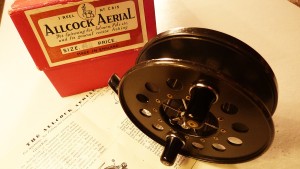
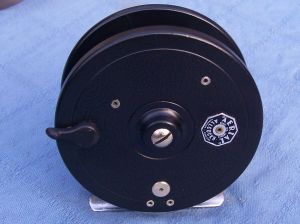 See how different the above reel is to the real 7950, particularly the backplate with it’s ‘teardrop’ shaped anti-reverse lever. Another mistake in the Guides!
See how different the above reel is to the real 7950, particularly the backplate with it’s ‘teardrop’ shaped anti-reverse lever. Another mistake in the Guides!
The last version of the Aerial was called the Match Aerial, (a bit too similar to the pre-war Aerial Match) 
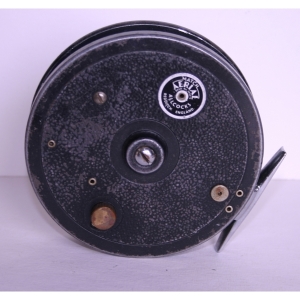 This slightly paint-worn reel shows the ‘dimpled’ casting finish on the Match Aerial back. Note, it’s also lost its check knob…….. And lastly, after Allcocks were shut down by new owners Shakespeare they eventually gave permission to an ex-employee , the late Fred Crouch, make the reel again using the old casting molds, but when he went to collect them they’d been thrown out, so he had some more made at huge expense only for these to crack in time and it was financially impossible to replicate them. Fred also offered a new wide drum, here is a late Fred Crouch wide drum:
This slightly paint-worn reel shows the ‘dimpled’ casting finish on the Match Aerial back. Note, it’s also lost its check knob…….. And lastly, after Allcocks were shut down by new owners Shakespeare they eventually gave permission to an ex-employee , the late Fred Crouch, make the reel again using the old casting molds, but when he went to collect them they’d been thrown out, so he had some more made at huge expense only for these to crack in time and it was financially impossible to replicate them. Fred also offered a new wide drum, here is a late Fred Crouch wide drum: 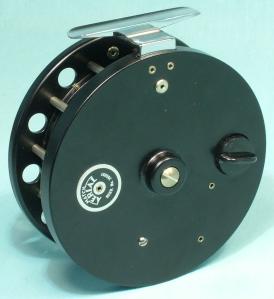
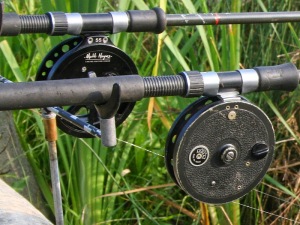 At first the reel on the rod in the foreground looks like a late Allcocks Aerial, but look closely and you see the badge has no Allcocks name…..it’s an early Crouch reel with the hard to replicate ‘dimpling’ http://fredcrouchreels.co.uk/history/ ……………………………………………………………………….. To this day, amateurs and professionals alike copy these old designs, try to make little improvements on them and even cheap far-Eastern copies are made.
At first the reel on the rod in the foreground looks like a late Allcocks Aerial, but look closely and you see the badge has no Allcocks name…..it’s an early Crouch reel with the hard to replicate ‘dimpling’ http://fredcrouchreels.co.uk/history/ ……………………………………………………………………….. To this day, amateurs and professionals alike copy these old designs, try to make little improvements on them and even cheap far-Eastern copies are made.
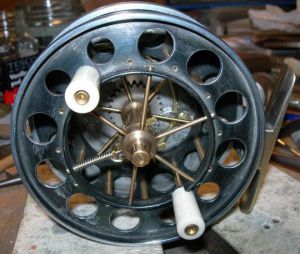 This apparently old reel was made by Paul Witcher just a few years ago. It is called the ‘Bisterne’ after a stretch of the Hampshire Avon near the village of that name. Paul no longer makes reels, but this is how he did it; a master in the workshop: http://paulwitcherproductions.com/page8.htm You might enjoy Paul’s work behind a camera too: https://vimeo.com/2343074 https://vimeo.com/38383483 Clever old devil, isn’t he……? Those two short clips were produced as trailers for two DVDs, both of which can be purchased through Paul’s site: http://paulwitcherproductions.com/page3.htm
This apparently old reel was made by Paul Witcher just a few years ago. It is called the ‘Bisterne’ after a stretch of the Hampshire Avon near the village of that name. Paul no longer makes reels, but this is how he did it; a master in the workshop: http://paulwitcherproductions.com/page8.htm You might enjoy Paul’s work behind a camera too: https://vimeo.com/2343074 https://vimeo.com/38383483 Clever old devil, isn’t he……? Those two short clips were produced as trailers for two DVDs, both of which can be purchased through Paul’s site: http://paulwitcherproductions.com/page3.htm
This last little bit of this blog will remain as a memorial to The Roach Master, ….the late John Searl, who featured in both Paul’s productions. Talented angler, published author, illustrator and hugely talented artist.
R.I.P.
